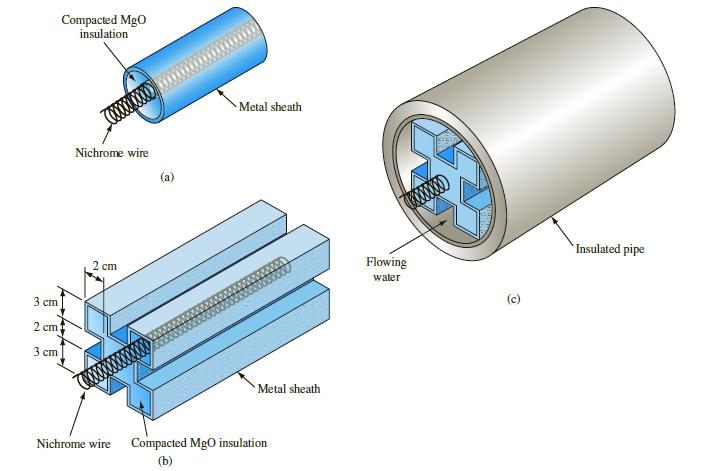Electrical resistance heaters are usually made from coils of nichrome wire. The coiled wire can be supported
Question:
Electrical resistance heaters are usually made from coils of nichrome wire. The coiled wire can be supported between insulators and backed with a reflector, for example, as in a supplemental room heater. In other applications, however, it is often necessary to protect the nichrome wire from its environment. An example of such an application is a process heater where a flowing fluid is to be heated. In such a case, the nichrome wire is embedded in an electrical insulator and covered by a metal sheath. Sketch
(a) shows the construction details. Since the sheathed heater is often used to heat a fluid flowing over its outside surface, it may be necessary to increase the surface area of the heater sheath. A proposed design for such an application is shown in sketch
(b) The preliminary design of a fast-response hot- water heater using this proposed heater element design is shown in sketch
(c) The heating element is located inside a pipe carrying the water to be heated. The heating element dissipates 4800 watts per meter length and has a maximum temperature limit of 200ºC. Water is to be heated to 65ºC by the device and the surface of the heating element should not exceed 100ºC to avoid boiling.
For simplicity, assume that the heat dissipated by the nichrome wire is distributed uniformly over the cross section of the heating element shown in sketch (b) and that the thermal conductivity of the MgO insulation is 2 W/m K. You may also assume that the metal sheath is very thin. First, perform an order-of-magnitude analysis to estimate the required convective heat transfer coefficient and to determine whether the temperature constraints given above can be met. Next, use analytical tools developed in this chapter to refine your answer.

Step by Step Answer:

Principles Of Heat Transfer
ISBN: 9781305387102
8th Edition
Authors: Frank Kreith, Raj M. Manglik, Mark S. Bohn





